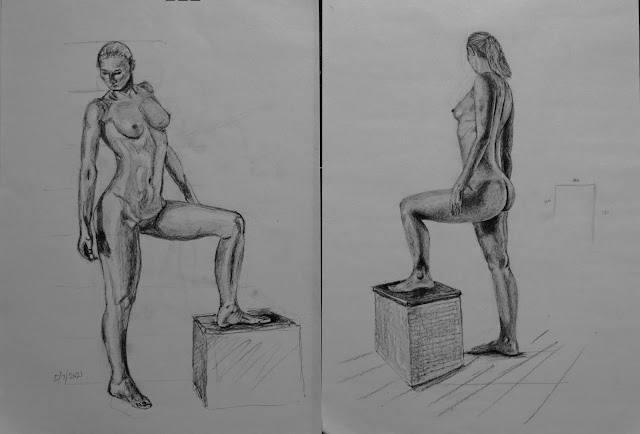One of my ultimate art goals is to develop the ability to draw figures in my paintings to add interest and also I feel it is a form of ‘product differentiation’. Many contemporary ‘hobby’ artists avoid the human form and face because it is difficult. Difficult sounds to me like a good reason to try to master the art!
I went to a set of
five morning sessions delivered by Paul Birchall. It was part of the local
university summer school; I think it was at the start of 2019. After I retired I
returned to classes with Paul with the intention of developing my figure
drawing skills further. That was at the start of 2020, Covid 19 then came along
and art classes were put on hold.
Paul suggested a few
practice exercises I could undertake during the start of the Covid period but
with time the isolation and distractions of dealing with the new reality ended
those efforts.
Paul has started
providing tuition via zoom with a new arrangement whereby he acts as coach. I
enlisted a week ago and began a new venture into the tricky realm of
representing humans by drawing a skull.
 |
| Drawing of human skull |
The work shown here is
on an A3 sheet of 60gsm layout paper. I used Lyra Art Design pencils ranging
from HB to 9B. I usually start by getting the overall shape and proportions
right with an outline drawing. On this occasion I then sent a quick snapshot of
the outline to Paul for comment.. Once the master had approved of that stage, I
followed up with an exercise in shading to define the form by delineating areas
of cast and form shadows.
The initial outline
work uses the point of the pencil and a putty rubber (extensively). The
definition of form requires the use of the side of the pencil held at about 30
degrees to the paper. I find that during this process any error in the form
drawing becomes apparent and so some putty rubber and line work is still
required.
Following the skull
drawing I was assigned the task of drawing figures from my head without any
reference material. I tried a few, disaster! Following that I was to cast a
photograph of an artist model up on a large flat surface. Then, set up an easel
and draw the model form ‘life’. I have completed two of these so far.
The image above shows
the first figure I drew on the right and the second attempt on the left. Both
are A3 drawings created on 60 gsm layout paper. The first drawing was created
using the Derwent Graphic pencils, the second Lyra Art Design pencils. The Lyra
pencils work better on the smooth and slippery layout paper. Each image required
about eight to ten hours effort. I spread the time to produce these drawings
over two days for each one. Constantly comparing the drawing to what is on the
screen in tiring and requires concentration. As soon as I catch myself working
the image without direct eye contact with the feature I am creating, I stop. I will
explain my reasoning for this practice below. The model was photographed and made available to artists by 'Pose Space' on the Internet.
A number of texts that
I have read discuss the issue of drawing what is visible, not what our mind
thinks the subject should look like! This is the perception versus vision
problem that one has to overcome to become an artist of real world subjects. My
interpretation of what the various authors say is that our eye acts like a
camera and creates a digital image. Our conscious mind looks briefly at the
image projected from the eye, and then it searches for pre-existing models of
the displayed image. Once the mind finds the ‘right’ model, it uses this model,
updated with a few new details from the image on the eye, and acts accordingly.
The problem of course is that when it
comes to people, and particularly portraits, the viewer is as conversant in the
reality as the artist! This results in viewers’ ability to judge the ‘truth’ of
the artwork. This is what makes figures and faces so difficult to represent.
This is a list of some
books that address the issue of perception versus vision.
Edwards, B. (1988)
Drawing on the artist within. How to release your hidden creativity. Glasgow:
Fontana / William Collins and Sons.
Elliott, V. (2007)
Traditional oil painting. Advanced techniques and concepts from the Renaissance
to the present. New York: Watson-Guptill Publications.
Jacobs, T.S. (1986)
Drawing what the eye sees. Mineola, New York: Dover Publications Inc.
